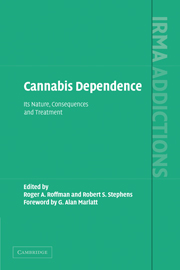Book contents
- Frontmatter
- Contents
- List of Contributors
- Acknowledgments
- Executive Summary
- Foreword
- Part I The Nature of Cannabis Dependence
- 1 Themes in the History of Cannabis Dependence
- 2 The Diagnosis of Cannabis Dependence
- 3 Understanding the Pharmacology and Physiology of Cannabis Dependence
- 4 The Epidemiology of Cannabis Dependence
- 5 The Adverse Health and Psychological Consequences of Cannabis Dependence
- Part II Interventions with Cannabis-Dependent Adults
- Part III Interventions with Cannabis-Dependent Adolescents and Young Adults
- Part IV Policy
- Part V Conclusion
- Index
3 - Understanding the Pharmacology and Physiology of Cannabis Dependence
from Part I - The Nature of Cannabis Dependence
Published online by Cambridge University Press: 29 October 2009
- Frontmatter
- Contents
- List of Contributors
- Acknowledgments
- Executive Summary
- Foreword
- Part I The Nature of Cannabis Dependence
- 1 Themes in the History of Cannabis Dependence
- 2 The Diagnosis of Cannabis Dependence
- 3 Understanding the Pharmacology and Physiology of Cannabis Dependence
- 4 The Epidemiology of Cannabis Dependence
- 5 The Adverse Health and Psychological Consequences of Cannabis Dependence
- Part II Interventions with Cannabis-Dependent Adults
- Part III Interventions with Cannabis-Dependent Adolescents and Young Adults
- Part IV Policy
- Part V Conclusion
- Index
Summary
Growing evidence from rodent, dog, monkey, and human studies indicates that prolonged administration of cannabis results in physical dependence. The goal of this chapter is to present an overview of this research and highlight several important advances that have been made in both characterizing and delineating the molecular mechanisms underlying this dependence. We will first provide a brief summary of several important advances that have been made in the basic understanding of the actions of cannabis and its interaction with an endogenous cannabinoid system. In addition, the results from both animal and in vitro studies that have enhanced our understanding of cannabinoid dependence will be described. Of considerable interest is the proposed reciprocal relationship between cannabinoid and opioid systems in drug dependence.
Basic Neuropharmacology of Cannabis Effects and the Existence of an Endocannabinoid System
The pharmacological effects and potential medicinal uses of cannabis have been known since antiquity, thousands of years before the elucidation of the structure of Δ9-tetrahydrocannabinol (Δ9-THC), the primary psychoactive constituent of this plant (Gaoni & Mechoulam, 1964). In addition to Δ9-THC, cannabis contains over 400 chemical constituents, 66 of which have been classified as cannabinoids (Turner et al., 1980). Moreover, hundreds of cannabinoid agonists have also been synthesized in the laboratory. For decades the pharmacological activity of these highly hydrophobic drugs was attributed to a non-specific mechanism of general membrane perturbation.
Keywords
- Type
- Chapter
- Information
- Cannabis DependenceIts Nature, Consequences and Treatment, pp. 37 - 57Publisher: Cambridge University PressPrint publication year: 2006
- 1
- Cited by



